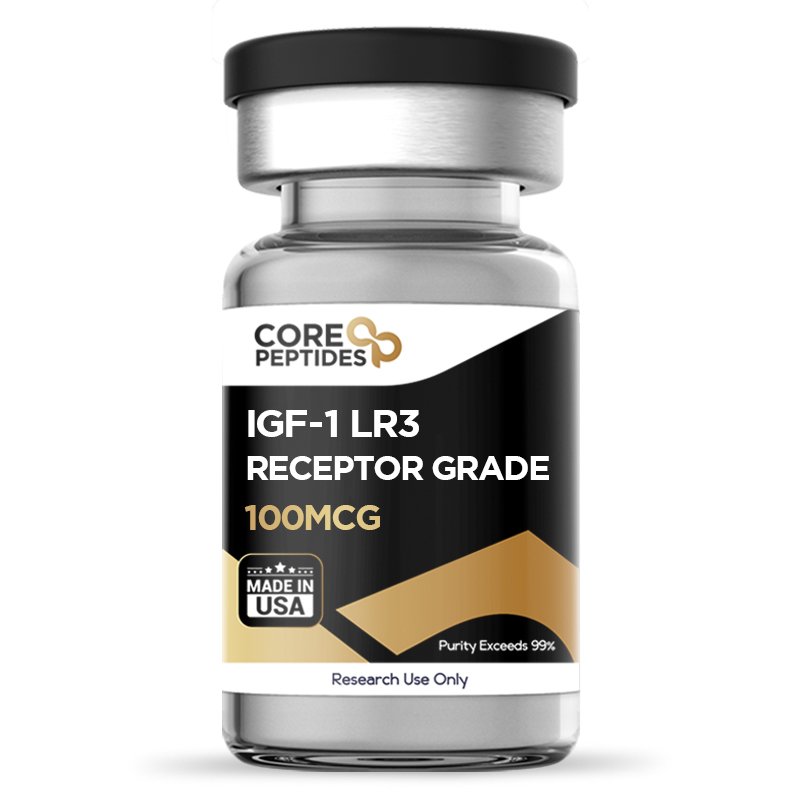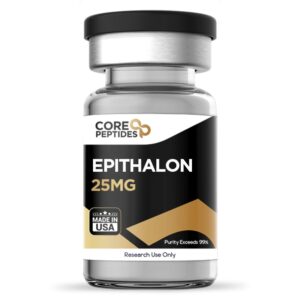Description
Receptor Grade IGF-1 LR3 Peptide – Long R3 Insulin-Like Growth Factor-1
Molecular Formula: C₄₀₀H₆₂₅N₁₁₁O₁₁₅S₉
Molecular Weight: 9117.5 g/mol
Other Names: Long-(Arg3) IGF-1, IGF-1 Long R3, Insulin-like growth factor long chain R3
Form: Lyophilized Powder
Purity: Receptor Grade – High purity suitable for research applications
Storage: -20°C, dry and protected from light
Use: For research and laboratory purposes only; not for human consumption
Overview
Insulin-like Growth Factor-1 (IGF-1) is a naturally occurring protein composed of 70 amino acids that plays a pivotal role in regulating cellular growth, tissue development, and metabolic function. Receptor Grade IGF-1 LR3 is a synthetic variant of IGF-1, featuring a 13-amino-acid extension at the N-terminal and the substitution of arginine for glutamic acid at position 3, which is why it is commonly referred to as IGF-1 Long R3 (LR3-IGF-1).
The structural modifications in IGF-1 LR3 confer enhanced anabolic potential, increased receptor affinity, and reduced binding to IGF-binding proteins (IGFBPs), allowing for greater bioavailability in experimental settings. Its similarity to insulin and natural IGF-1 makes it a valuable tool for studies investigating cell growth, tissue development, metabolic signaling, and anabolic mechanisms. The “Receptor Grade” classification indicates a higher purity standard than media-grade IGF-1 LR3, making it suitable for sensitive in vitro and in vivo research applications.
Chemical Properties
-
Molecular Formula: C₄₀₀H₆₂₅N₁₁₁O₁₁₅S₉
-
Molecular Weight: 9117.5 g/mol
-
Other Names: Long-(Arg3) IGF-1, IGF-1 Long R3
Research Highlights
Anabolic Potential
Although primarily intended for cell culture studies, limited animal research demonstrates that IGF-1 LR3 exhibits substantial anabolic activity. In one study involving normal and dexamethasone-induced catabolic murine models, IGF-1 LR3 appeared 1.5–2 times more potent than IGF-1, promoting weight gain, increased visceral organ mass, and improved feed efficiency under continuous administration. Furthermore, IGF-1 LR3 reduced the excretion of Nτ-methylhistidine, a marker of muscle protein breakdown, up to threefold compared to IGF-1, highlighting its potential in mitigating catabolic effects and supporting tissue anabolism.
Such findings suggest that IGF-1 LR3 may offer enhanced anabolic effects compared to natural IGF-1, although outcomes may vary depending on experimental conditions. Additional studies indicate that IGF-1 analogs, including LR3, may be relevant in growth deficiency models, where peptide exposure has been associated with measurable increases in length and tissue development.
Insulin Receptor Sensitivity and Glucose Metabolism
IGF-1 LR3 has been shown to influence glucose uptake and enhance metabolic signaling, potentially through IGF-1 receptor-mediated pathways as well as IGF-independent mechanisms involving PI3K and AMPK pathways. Research suggests that IGF-1 LR3 may promote GLUT-4 translocation and glucose entry into cells, which could be relevant in studies of insulin sensitivity, energy balance, and metabolic regulation.
Cell Lifespan and Tissue Protection
Studies in murine models indicate that IGF-1 LR3 may contribute to the preservation of cellular function by reducing markers of physiological decline, such as muscle damage and neuronal deficits. While clinical data are limited, preliminary findings suggest that IGF-1 LR3 could support longer functional lifespans of cells in tissue-specific research models.
Effects on Muscle Cells and Myostatin Regulation
IGF-1 LR3 has been studied for its potential to counteract the inhibitory effects of myostatin, a protein that limits muscle growth. Experimental data in female murine models demonstrated that IGF-1 LR3 may promote lean muscle mass, reduce fat accumulation, and prevent apoptosis, highlighting its potential for research on muscle physiology and hypertrophy mechanisms.
Pharmacokinetics and Tissue Distribution
Compared to natural IGF-1, IGF-1 LR3 demonstrates faster serum clearance and wider tissue distribution, likely due to lower binding affinity to IGFBPs. In animal studies, higher concentrations of IGF-1 LR3 were detected in tissues such as kidneys, ovaries, and adrenal glands, suggesting unique tissue targeting properties. These pharmacokinetic characteristics may provide a more consistent bioavailability in experimental models, supporting its use in diverse research applications.
Conclusion
Receptor Grade IGF-1 LR3 is a high-purity, synthetic IGF-1 analog with enhanced receptor binding, anabolic potential, and metabolic activity compared to endogenous IGF-1. It is an ideal tool for research focused on cellular growth, muscle physiology, metabolism, and tissue regeneration. As a laboratory-grade peptide, it is intended strictly for in vitro and in vivo research and is not approved for human consumption.
References
-
Tomas, F. M., Knowles, S. E., Owens, P. C., et al. (1992). Insulin-like growth factor-I (IGF-I) and variants are anabolic in dexamethasone-treated rats. Biochem J, 282, 91–97.
-
Human Insulin-like growth factor. Protein Data Bank in Europe. https://www.ebi.ac.uk/pdbe/entry/pdb/1gzr
-
PubChem Substance Record for SID 381123731. https://pubchem.ncbi.nlm.nih.gov/substance/381123731
-
Anderson, L. J., Tamayose, J. M., Garcia, J. M. (2018). Use of growth hormone, IGF-I, and insulin for anabolic purpose. Mol Cell Endocrinol, 464, 65–74.
-
Assefa, B., Mahmoud, A. M., et al. (2017). IGF-binding protein-2 induces GLUT-4 translocation and glucose uptake independently of IGF-1. Oxid Med Cell Longev, 2017.
-
Sonntag, W. E., Csiszar, A., et al. (2012). Roles of growth hormone and IGF-1 in mammalian aging. J Gerontol A Biol Sci Med Sci, 67A(6), 587–598.
-
Li, N., Yang, Q., et al. (2016). Myostatin attenuation in vivo reduces adiposity and activates adipogenesis. Endocrinology, 157(1), 282–291.
-
Bastian, S. E., Walton, P. E., et al. (1993). Plasma clearance and tissue distribution of labelled IGF-I and LR3IGF-I in rats. J Endocrinol, 138(2), 327–336.





Reviews
There are no reviews yet.